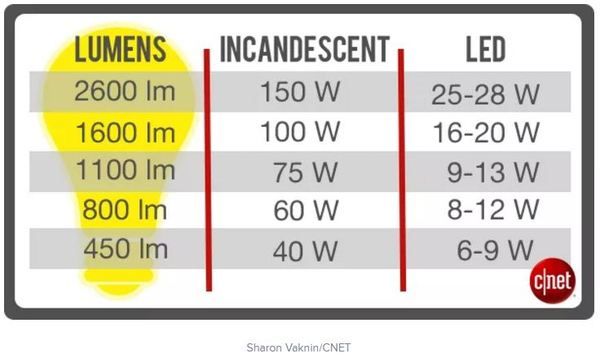For the average person, lighting is no big deal. Flip a switch. Change a burnt out bulb. That's about it. It's a completely different story for retailers, where lighting literally sets the stage, the mood, and even focuses customer attention on predetermined locations and products.
Illuminating Watts Going On
Before considering the "why" of converting from incandescent or fluorescent to LED, retailers should understand the basics of comparison between traditional bulb referencing and the new standards.
We are accustomed to referencing bulbs in terms of wattage. Although we tend to think of wattage is the lighting output of a bulb, it is really the measurement of the energy the bulb consumes. The true measure of a bulb's capacity to illuminate is measured in lumens. CNet published a chart that compares the wattage of incandescent bulb versus an LED bulb based upon the same illumination ability (lumens).

Other Consumption Comparisons
The following information sheds some light on additional considerations.
In the first illustration, although the initial cost of a single bulb is 66% higher, the life expectancy of the more expectancy of the LED bulb is 10,000 times longer. During the 20,000-hour life of the LED bulb, a halogen bulb would need to be replaced ten times. Therefore, the actual expenditure on a bulb-life comparison is $150 for a halogen bulb versus $25 for the LED. That is a cost saving of $125 per bulb. Multiply that by the number of bulbs in your store and we are talking about some substantial savings.
| TYPE | Initial Cost | Usage Hours |
| 75 Watt Halogen Bulb | $15.00 | 2,000 |
| 13 Watt LED Bulb | $25.00 | 20,000 |
In the second illustration, even though the LED cost is 5.7 times more than the halide, the LED lumens per watt efficiency is nearly twice that of a High Bay Halide bulb and its expected service life is five times greater. What is more, once a halide bulb reaches half of its service life expectancy, it also loses half of its luminosity. The LED continues to generate the same amount of light throughout its entire life cycle.
| TYPE | Initial Cost | Lumen/Watt | Usage Hours |
| 400 Watt Hough Bay Halide | $30.00 | 79.2 | 20,000 |
| 150 Watt LED | $200.00 | 150.0 | 100,000 |
Illuminating Energy Consumption
Applying the information in the chart, we can readily understand that a 100-Watt incandescent bulb consumes 100 Watts of energy to generate 1600 lumens. The same amount of illumination may be obtained with a 20-Watt LED bulb. In other words, the LED bulb generates the same amount of illumination using 80% less energy.
Now you know the first, and most obvious, reason for retailers to convert to LED lighting. Doing so could generate an 80% savings on the cost of lighting your stores. What was once considered a fixed expense has now become a variable. Anyone who understands a P&L also understands the need to control and reduce variable expenses.
Shifting the Spotlight from the Budget to the Environment
This is not really a long leap. If your bottom line can be positively impacted by a decrease in energy usage, then it naturally follows that the reduction in energy consumption will benefit the environment. By reducing your store's energy consumption, you also reduce your carbon footprint, making both the ecosystem and the EPA happy.
The federal and some state governments continue to move apace toward more energy efficient lighting. We should expect that trend to continue. If we have learned anything about legislative history in general or environmental regulation in specific, it is to expect what is now relatively voluntary to eventually become mandatory.
At this point, there is little question that energy conservation legislation will expand the demand for LED lighting. It is the type of regulation that can actually help reduce your facility maintenance expenses while improving store setting.

